Samsung SNB-5001, SNB-7001 User Manual

NETWORK CAMERA
User Manual
SNB-5001/SNB-7001

Network Camera
User Manual
Copyright
©2012 Samsung Techwin Co., Ltd. All rights reserved.
Trademark







 is the registered logo of Samsung Techwin Co., Ltd. The name of this product is the registered trademark of Samsung Techwin Co., Ltd.
is the registered logo of Samsung Techwin Co., Ltd. The name of this product is the registered trademark of Samsung Techwin Co., Ltd.
Other trademarks mentioned in this manual are the registered trademark of their respective company.
Restriction
Samsung Techwin Co., Ltd shall reserve the copyright of this document. Under no circumstances, this document shall be reproduced, distributed or changed, partially or wholly, without formal authorization of Samsung Techwin.
Disclaimer
Samsung Techwin makes the best to verify the integrity and correctness of the contents in this document, but no formal guarantee shall be provided. Use of this document and the subsequent results shall be entirely on the user’s own responsibility. Samsung Techwin reserves the right to change the contents of this document without prior notice.
Design and specifications are subject to change without prior notice.
The default password can be exposed to a hacking thread so it is recommended to change the password after installing the product.
Note that the security and other related issues caused by the unchanged password shall be responsible for the user.

overview
IMPORTANT SAFETY INSTRUCTIONS
1. |
Read these instructions. |
|
|
2. |
Keep these instructions. |
|
|
3. |
Heed all warnings. |
● |
|
OVERVIEW |
|
||
4. |
Follow all instructions. |
|
|
|
|
||
5. |
Do not use this apparatus near water. |
|
|
6. |
Clean only with dry cloth. |
|
|
7. |
Do not block any ventilation openings, Install in accordance with the manufacturer’s |
|
|
8. |
instructions. |
|
|
Do not install near any heat sources such as radiators, heat registers, stoves, or other |
|
|
|
9. |
apparatus (including amplifiers) that produce heat. |
|
|
Do not defeat the safety purpose of the polarized or grounding-type plug. A polarized |
|
|
|
|
plug has two blades with one wider than the other. A grounding type plug has two |
|
|
|
blades and a third grounding prong. The wide blade or the third prong are provided for |
|
|
|
your safety. If the provided plug does not fit into your outlet, consult an electrician for |
|
|
|
|
|
|
10. |
replacement of the obsolete outlet. |
|
|
Protect the power cord from being walked on or pinched particularly at plugs, |
|
|
|
11. |
convenience receptacles, and the point where they exit from the apparatus. |
|
|
Only use attachments/ accessories specified by the manufacturer. |
|
|
|
12. |
Use only with the cart, stand, tripod, bracket, or table specified by |
|
|
|
the manufacturer, or sold with the apparatus. When a cart is used, |
|
|
|
use caution when moving the cart/apparatus combination to avoid |
|
|
13. |
injury from tip-over. |
|
|
Unplug this apparatus during lighting storms or when unused for |
|
|
|
14. |
long periods of time. |
|
|
Refer all servicing to qualified service personnel. Servicing is required when the |
|
|
|
|
apparatus has been damaged in any way, such as power-supply cord or plug is |
|
|
|
damaged, liquid has been spilled or objects have fallen into the apparatus, the apparatus |
|
|
|
has been exposed to rain or moisture, does not operate normally, or has been dropped. |
|
|
English _3

overview
WARNING
TO REDUCE THE RISK OF FIRE OR ELECTRIC SHOCK, DO NOT EXPOSE THIS PRODUCT TO RAIN OR MOISTURE. DO NOT INSERT ANY METALLIC OBJECT THROUGH THE VENTILATION GRILLS OR OTHER OPENNINGS ON THE EQUIPMENT.
Apparatus shall not be exposed to dripping or splashing and that no objects filled with liquids, such as vases, shall be placed on the apparatus.
CAUTION
CAUTION
RISK OF ELECTRIC SHOCK.
DO NOT OPEN
CAUTION : TO REDUCE THE RISK OF ELECTRIC SHOCK.
DO NOT REMOVE COVER (OR BACK).
NO USER SERVICEABLE PARTS INSIDE.
REFER SERVICING TO QUALIFIED SERVICE PERSONNEL.
EXPLANATION OF GRAPHICAL SYMBOLS
The lightning flash with arrowhead symbol, within an equilateral triangle, is intended to alert the user to the presence of “dangerous voltage” within the product’s enclosure that may be of sufficient magnitude to constitute a risk of electric shock to persons.
The exclamation point within an equilateral triangle is intended to alert the user to the presence of important operating
and maintenance (servicing) instructions in the literature accompanying the product.
4_ overview

Class  construction
construction
An apparatus with CLASS  construction shall be connected to a MAINS socket outlet with a protective earthing connection.
construction shall be connected to a MAINS socket outlet with a protective earthing connection.
Battery
Batteries(battery pack or batteries installed) shall not be exposed to excessive heat such as sunshine, fire or the like.
Disconnection Device
Disconnect the main plug from the apparatus, if it’s defected. And please call a repair man in your location.
When used outside of the U.S., it may be used HAR code with fittings of an approved agency is employed.
CAUTION
These servicing instructions are for use by qualified service personnel only. To reduce the risk of electric shock do not perform any servicing other than that contained in the operating instructions unless you are qualified to do so.
The BNC Out terminal of the product is provided for easier installation, and is not recommended for monitoring purposes.
If you keep the BNC cable connected, a risk of lightening may cause damage or malfunction to the product.
Please use the input power with just one camera and other devices must not be connected.
OVERVIEW ●
English _5

overview
Please read the following recommend safety precautions carefully.
Do not place this apparatus on an uneven surface.
Do not install on a surface where it is exposed to direct sunlight, near heating equipment or heavy cold area.
Do not place this apparatus near conductive material.
Do not attempt to service this apparatus yourself.
Do not place a glass of water on the product.
Do not install near any magnetic sources.
Do not block any ventilation openings.
Do not place heavy items on the product.
User’s Manual is a guidance book for how to use the products.
The meaning of the symbols are shown below.
Reference : In case of providing information for helping of product’s usages
Notice : If there’s any possibility to occur any damages for the goods and human caused by not following the instruction
Please read this manual for the safety before using of goods and keep it in the safe place.
6_ overview

CONTENTS
OVERVIEW |
3 |
Important Safety Instructions |
3 |
9 |
Product Features |
9 |
Recomended PC Specifications |
|
10 |
What’s Included |
|
11 |
At a Glance |
OVERVIEW ●
INSTALLATION &
CONNECTION
14
NETWORK CONNECTION AND SETUP
19
14 Mounting the Lens
16 Connecting with other Device
19Connecting the Camera Directly to Local Area Networking
20Connecting the Camera Directly to a DHCP Based DSL/Cable Modem
21Connecting the Camera Directly to a PPPoE Modem
22Connecting the Camera to a Broadband Router with the PPPoE/Cable Modem
23Buttons used in IP Installer
24Static IP Setup
28Dynamic IP Setup
29Port Range Forward (Port Mapping) Setup
31 Connecting to the Camera from a
Shared Local PC
31Connecting to the Camera from a Remote PC via the Internet
English _7

overview
WEB VIEWER |
32 |
Connecting to the Camera |
33 |
Login |
|
32 |
34 |
Installing STW WebViewer Plugin |
35 |
Using the Live Screen |
|
SETUP SCREEN |
37 |
Setup |
37 |
Video Setup |
|
37 |
47 |
Network Setup |
55 |
Event Setup |
|
62 |
System Setup |
|
APPENDIX |
68 |
Specification |
73 |
Product Overview |
|
68 |
74 |
Troubleshooting |
75 |
Open Source Announcement |
|
76 |
License |
|
|
79 |
GPL/LGPL Software License |
8_ overview

PRODUCT FEATURES
• |
Multi-Streaming |
|
|
|
This network camera can display videos in different resolutions and qualities |
|
|
|
simultaneously using different CODECs. |
● |
|
|
|
||
• Web Browser-based Monitoring |
OVERVIEW |
|
|
• Alarm |
|
||
|
Using the Internet web browser to display the image in a local network environment. |
|
|
|
If an event occurs, the event-related video will be transferred to the email or FTP server |
|
|
|
specified by the user. |
|
|
• Video Motion Detection |
|
|
|
• |
Detects a motion from the video before triggering an event. |
|
|
Screen change detection feature |
|
|
|
|
If the monitoring is interrupted in any way, the camera will trigger the event alarm. |
|
|
• ONVIF Compliance
This product supports ONVIF.
For more information, refer to www.onvif.org.
RECOMENDED PC SPECIFICATIONS
•CPU : Intel(R) Core(TM)2 2.4 GHz or higher
•Operating System : Windows XP, VISTA, 7, Mac OS
•Resolution : 1280X1024 pixels or higher (32 bit color)
•RAM : 2GB or higher
•Web Browser : Internet Explorer 7 or later, Firefox 9 or later, Chrome 15 or later, Safari 5.1
or later
Neither a beta test version unlike the version released in the company website nor the developer version will be supported.
It is recommended to connect to IPv6 in Windows 7.
•Video Memory : 256MB or higher
JIf the driver of the video graphic adapter is not installed properly or is not the latest version, the video may not be played properly.
For a multi-monitoring system involving at least 2 monitors, the playback performance can be deteriorated depending on the system.
English _9
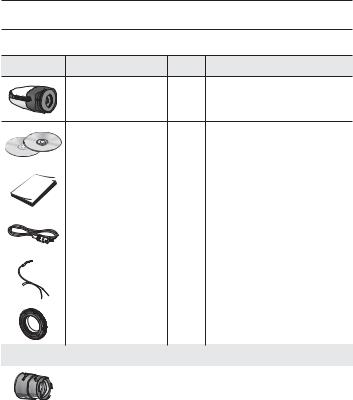
overview
WHAT’S INCLUDED
Please check if your camera and accessories are all included in the product package.
Appearance |
Item Name |
Quantity |
Description |
|
Camera |
1 |
|
|
Instruction book, |
2 |
|
|
|
Installer S/W CD, |
|
|
|
|
CMS S/W DVD |
|
|
|
|
Quick Guide (Optional) |
1 |
|
|
|
|
|
|
|
|
Cable for the testing monitor |
1 |
|
Used to test the camera connection to a |
|
|
portable display device |
||
|
|
|
|
|
|
|
|
|
|
|
Alarm Cable |
1 |
|
Used to connect to Alarm input |
|
|
|
|
|
|
C Mount Adapter |
1 |
|
Used to install the C Mount camera lens |
|
|
|
|
|
|
Lens Options (not included) |
|
||
|
CS/C Lens |
|
|
Optional lens to be inserted in a camera |
|
|
|
|
|
10_ overview
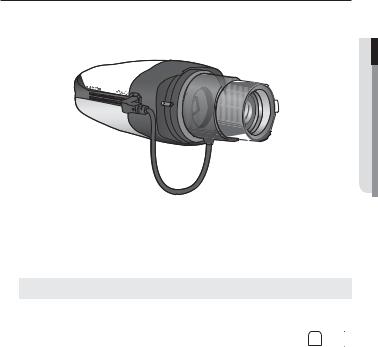
AT A GLANCE
Front Side
|
|
|
b c |
|||
|
|
|
|
|
|
|
|
|
|
|
|
|
|
|
|
|
|
|
|
|
|
|
|
|
|
|
|
|
|
|
|
|
|
|
|
|
|
|
|
|
|
|
|
|
|
|
|
|
|
|
|
|
|
|
|
|
|
|
|
|
|
|
|
|
|
|
|
|
|
|
|
|
|
|
|
|
|
|
|
|
|
|
|
|
|
|
|
|
|
|
|
|
|
|
|
|
|
|
|
|
|
|
|
|
|
|
|
|
|
|
|
|
|
|
|
|
|
|
|
|
|
|
|
|
|
|
|
|
|
|
|
|
|
|
|
|
|
|
|
|
|
|
|
|
|
|
|
|
|
|
|
|
|
|
|
|
|
|
|
|
|
|
|
|
|
|
|
|
|
|
|
|
|
|
|
|
|
|
|
|
|
|
|
|
|
|
|
|
OVERVIEW ●
Item |
Description |
||||||||||||||||||
|
Used to fix the camera on a mounting bracket. |
||||||||||||||||||
Mounting Bracket |
The screw size : use this screw to fix the mounting bracket. |
||||||||||||||||||
1/4" - 20UNC (20THREAD/1") |
|
|
|
|
|
|
|
|
|
|
|
||||||||
Screw Hole |
L : 4.5mm±0.2mm (ISO Standard), or 0.197" |
|
|
|
|
|
|
|
|
|
|
|
|
|
|
|
|
|
|
|
|
|
|
|
|
|
|
|
|
|
|||||||||
|
(ASA Standard) |
|
|
|
|
|
|
|
|
|
|
|
|
|
|
|
|
|
|
Auto Iris Lens |
Used to supply power and output signal to control the iris of the lens. |
||||||||||||||||||
b Connector |
|||||||||||||||||||
English _11

overview
|
Item |
Description |
c FBL Lever |
Adjust the FBL (Flange-Back Length) value according to the lens. |
|
|
|
|
|
Auto Iris Lens |
Installed on the lens adaptor. |
(Optional) |
||
MWipe out a dirty surface of the lens softly with a lens tissue or cloth to which you have applied ethanol.
Mounting Bracket is not included.
For more information to use mounting bracket, refer to the product’s documentation.
12_ overview
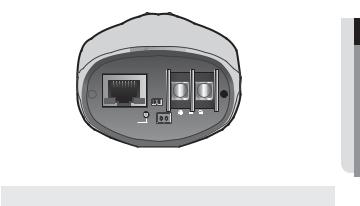
Rear Side
b c
●
NETWORK |
OVERVIEW |
|
|
ALARM |
|
|
IN |
|
ACT |
LINK |
|
|
DC12V |
|
|
RESET |
|
|
VIDEO |
|
|
|
|
Item |
Description |
Network Port |
Used to connect a PoE or LAN cable. |
|
|
b Lightning protective |
Used to discharge the lightning current safely outside in order to protect the |
grounding port |
camera. |
c Power Port |
Used to plug the power cable. |
|
|
Alarm Input Port |
Used to connect the alarm input signal. |
|
|
Video Out Port |
Analog video output port. (for installation) |
|
|
|
Resets the camera settings to the default. |
|
Press and hold for about 5 seconds to reboot the system. |
Reset Button |
J If you reset the camera, the network settings will be adjusted so that |
DHCP can be enabled. If there is no DHCP server in the network, you |
|
|
must run the IP Installer program to change the basic network settings |
|
such as IP address, Subnet mask, Gateway, etc., before you can |
|
connect to the network. |
English _13

installation & connection
MOUNTING THE LENS
Disconnect the power before proceeding.
M The C lens and CS lens are not included in the product package.
Mounting the lens onto the C/CS mount camera
1.Fit the lens into the mounting screw hole and turn it clockwise. Tighten the screw. Then, it rotates in SLIP mode.
C/CS Lens
2.Turn it clockwise until it contacts on the stopper and stops.
3.As you can turn it counter clockwise from the stop point to rotate it in Slip mode, adjust the angle to your preference within the range.
4.Connect the lens cable to the camera connector.
14_ installation & connection
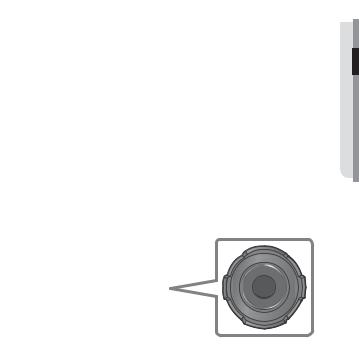
5.Use the focus lever and zoom lever to fit the zoom factor and focus. Then, fix the lens with the camera.
CONNECTION & INSTALLATION ●
Using a lens with hood
The round hood is mounted on the camera lens, which is designed to prevent flare/ghost/ light spreading. If it is installed improperly, it may cause shading on the screen.
Install the hood so that the wider side is placed vertically; and the narrower side is put horizontally.
English _15
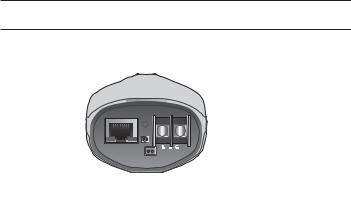
installation & connection
CONNECTING WITH OTHER DEVICE
NETWORK
Monitor (for installation)
ALARM
IN
ACT |
LINK |
|
DC12V |
|
VIDEO |
Power
Ethernet
JThe BNC Out terminal of the product is provided for easier installation, and is not recommended for monitoring purposes.
If you keep the BNC cable connected, a risk of lightening may cause damage or malfunction to the product.
Ethernet Connection
Connect the Ethernet cable to the local network or to the Internet.
Power Supply
Use the screwdriver to connect each line (+, –) of the power cable to the corresponding power port of the camera.
JIfPoE.both PoE and DC12V are applied simultaneously, the product will be supplied with power from
-You can also use a router featuring PoE (Power over Ethernet) to supply power to the camera.
-Use PoE (Power over Ethernet) that is compliant with the IEEE802.3af protocols.
-It is advisable to use only one power source from PoE and DC12V.
16_ installation & connection

Be careful not to reverse the polarity when you connect the power cable.
-Please connect the power adapter when the installation is completed.
-As shown in the table below, you may encounter a voltage-sag depending on the wire length. If you use an excessively long wire for camera connection, the camera may not work properly.
Electrical Resistance of Copper Wire at [20°C (68°F)]
Copper Wire Gauge (AWG) |
#24(0.22mm2) |
#22(0.33mm2) |
#20(0.52mm2) |
#18(0.83mm2) |
Resistance (Ω/m) |
0.078 |
0.050 |
0.030 |
0.018 |
Drop Voltage (V/m) |
0.028 |
0.018 |
0.011 |
0.006 |
Recommended Distance (m) |
Less than 20 |
Less than 30 |
Less than 30 |
Less than 30 |
Alarm input Wiring Diagram
CONNECTION & INSTALLATION ●
ALARM IN
1 |
(5mA sink) |
2
GND
English _17
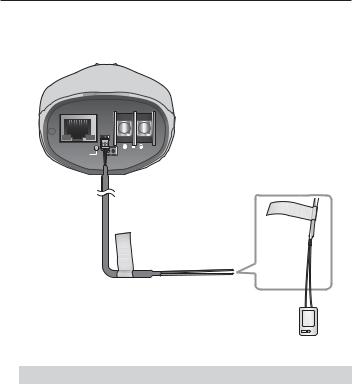
installation & connection
To connect to the alarm input port
Connect the alarm cable to the ALARM IN port in the rear panel.
NETWORK |
|
|
ALARM |
|
IN |
ACT |
LINK |
|
DC12V |
|
RESET |
|
VIDEO |
B
ROWN (ALARM BLACK (GND)
IN)
|
|
|
SENSOR |
|
|
|
|
|
|
Port |
Description |
Port |
Description |
|
ALARM IN |
Alarm Input Sensor Port |
GND |
GND port for the sensor |
|
To connect the external sensor
Connect one strand of each signal line (2-strand) of the sensors to the [ALARM IN] port, and connect the other strand to the [GND] port.
18_ installation & connection
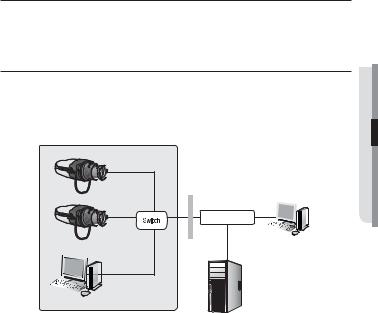
network connection and setup
You can set up the network settings according to your network configurations.
CONNECTING THE CAMERA DIRECTLY TO LOCAL AREA NETWORKING
Connecting to the camera from a local PC in the LAN
1.Launch an Internet browser on the local PC.
2.Enter the IP address of the camera in the address bar of the browser.
Camera |
|
|
|
|
INTERNET |
Camera |
Firewall |
External Remote PC |
|
|
|
Local PC |
|
DDNS Server |
|
(Data Center, KOREA) |
<Local Network>
MA remote PC in an external Internet out of the LAN network may not be able to connect to the camera installed in the intranet if the port-forwarding is not properly set or a firewall is set. In this case, to resolve the problem, contact your network administrator.
By factory default, the IP address will be assigned from the DHCP server automatically. If there is no DHCP server available, the IP address will be set to 192.168.1.100.
To change the IP address, use the IP Installer.
For further details on IP Installer use, refer to “Static IP Setup”. (Page 24)
SETUP AND CONNECTION NETWORK ●
English _19
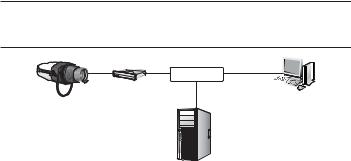
network connection and setup
CONNECTING THE CAMERA DIRECTLY TO A DHCP BASED DSL/CABLE MODEM
INTERNET 
DSL/Cable Modem
External Remote PC
Camera
DDNS Server
(Data Center, KOREA)
1.Use the cross LAN cable to connect the network cable directly to your PC.
2.Run the IP Installer and change the IP address of the camera so that you can use the web browser on your desktop to connect to the Internet.
3.Use the Internet browser to connect to the camera.
4.Move to [Setup] page.
5.Move to [Network] – [DDNS] and configure the DDNS settings.
6.Move to [Network] – [Interface], and set the network type to [DHCP].
7.Connect the camera, which was removed from your PC, directly to the modem.
8.Restart the camera.
MFor registering the DDNS settings, refer to “Registering with DDNS”. (page 49)
For configuring the DDNS settings, refer to “DDNS”. (page 48)
For setting the network type, refer to “Interface”. (page 47)
20_ network connection and setup
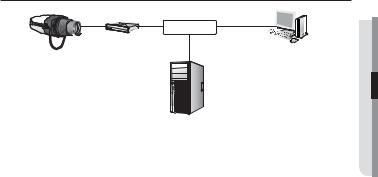
CONNECTING THE CAMERA DIRECTLY TO A PPPoE
MODEM
INTERNET 
PPPoE Modem
External Remote PC
Camera
DDNS Server
(Data Center, KOREA)
1.Use the cross LAN cable to connect the network cable directly to your PC.
2.Run the IP Installer and change the IP address of the camera so that you can use the web browser on your desktop to connect to the Internet.
3.Use the Internet browser to connect to the camera.
4.Move to [Setup] page.
5.Move to [Network] – [DDNS] and configure the DDNS settings.
6.Move to [Network] – [Interface], and set the network type to [PPPoE].
7.Connect the camera, which was removed from your PC, directly to the modem.
8.Restart the camera.
MFor registering the DDNS settings, refer to “Registering with DDNS”. (page 49)
For configuring the DDNS settings, refer to “DDNS”. (page 48)
For setting the network type, refer to “Interface”. (page 47)
SETUP AND CONNECTION NETWORK ●
English _21
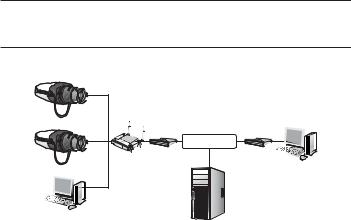
network connection and setup
CONNECTING THE CAMERA TO A BROADBAND ROUTER WITH THE PPPoE/CABLE MODEM
This is for a small network environment such as homes, SOHO and ordinary shops.
Camera |
|
|
|
|
INTERNET |
Broadband |
PPPoE or |
PPPoE or |
Cable Modem |
Cable Modem |
|
Router |
|
External Remote PC |
Camera |
|
|
|
|
DDNS Server |
Local PC |
|
(Data Center, KOREA) |
|
|
Configuring the network settings of the local PC connected to a
Broadband Router
Configuring the network settings of the local PC connected to a Broadband Router, follow the instructions below.
•Select : <Network Neighborhood> <Properties> <Local Area Connection>
<Properties> <General> <Internet Protocol (TCP/IP)> <Properties> <Obtain an IP address automatically> or <Use the following IP address>.
•Follow the instructions below if you select <Use the following IP address>: ex1) If the address (LAN IP) of the Broadband Router is 192.168.1.1
IP address : 192.168.1.100 Subnet Mask : 255.255.255.0 Default Gateway : 192.168.1.1
ex2) If the address (LAN IP) of the Broadband Router is 192.168.0.1 IP address : 192.168.0.100
Subnet Mask : 255.255.255.0 Default Gateway : 192.168.0.1
ex3) If the address (LAN IP) of the Broadband Router is 192.168.xxx.1 IP address : 192.168.xxx.100
Subnet Mask : 255.255.255.0 Default Gateway : 192.168.xxx.1
MFor the address of the Broadband Router, refer to the product’s documentation.
Refer to the “Port Range Forward (Port Mapping) Setup” section of the Broadband Router’s documentation. (Page 29)
22_ network connection and setup
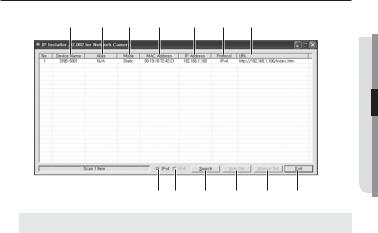
BUTTONS USED IN IP INSTALLER
b c
SETUP AND CONNECTION NETWORK ●
|
|
|
m |
|
|
|
|
Item |
|
Description |
|
Device Name |
Model name of the connected camera. |
|
|
Click the column to sort the list by model name. |
|||
|
However, search will be stopped if clicked during the search. |
||
b Alias |
This function is not currently implemented. |
|
|
c Mode |
Displays either <Static>, <Dynamic> or <PPPoE> for the current network |
||
connection status. |
|
|
|
MAC(Ethernet) |
Ethernet address for the connected camera. |
|
|
Click the column to sort the list by Ethernet address. |
|||
Address |
However, search will be stopped if clicked during the search. |
||
IP Address |
IP address. |
|
|
Click the column to sort the list by IP address. |
|
||
|
However, search will be stopped if clicked during the search. |
||
Protocol |
Network setting for the camera. |
|
|
The factory default is “IPv4”. |
|
|
|
|
Cameras with the IPv6 setting will be displayed “IPv6”. |
||
English _23

network connection and setup
Item |
Description |
URL |
DDNS URL address enabling access from the external Internet. |
However, this will be replaced with the <IP Address> of the camera if |
|
|
DDNS registration has failed. |
IPv4 |
Scans for cameras with the IPv4 setting. |
IPv6 |
Scans for cameras with the IPv6 setting. |
Activated in an IPv6 compliant environment. |
|
Search |
Scans for cameras that are currently connected to the network. |
However, this button will be grayed out if neither IPv4 nor IPv6 is checked. |
|
Auto Set |
The IP Installer automatically configures the network settings. |
Manual Set |
You should configure the network settings manually. |
m Exit |
Exits the IP Installer program. |
MFor the IP installer, use only the installer version provided in the installation CD or use the latest one if available. You can download the latest version from the Samsung web site (www.samsungcctv.com).
STATIC IP SETUP
Manual Network Setup
Run <IP Installer_vX.XX.exe> to display the camera search list.
At the initial startup, both [Auto Set] and [Manual Set] will be grayed out.
MFor cameras found with the IPv6 setting, these buttons will be grayed out as the cameras do not support this function.
1.Select a camera in the search list. Find the MAC (Ethernet) address labeled on the rear of the camera. Both the [Auto Set] and [Manual Set] buttons will be activated.
2.Click [Manual Set].
The Manual Setting dialog appears. The default values of <IP Address>,
<Subnet Mask>, <Gateway>, <HTTP Port> and <VNP Port> of the camera will be displayed.
24_ network connection and setup
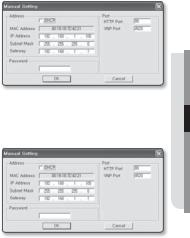
3.In the <Address> pane, provide the necessary information.
•MAC (Ethernet) Address : The MAC (Ethernet) address of the applicable camera will be set automatically so you don't need to input it manually.
MYou can configure the static IP settings only if the DHCP checkbox is unchecked.
If not using a Broadband Router
For setting <IP Address>, <Subnet Mask>, and <Gateway>, contact your network administrator.
4.In the <Port> pane, provide necessary information.
•HTTP Port : Used to access the camera using the Internet browser, defaulted to 80. Use the spin button to change the HTTP Port value.
•VNP Port : Used to control the video signal transfer, defaulted to 4520.
5.Enter the password.
This is the login password for the “admin” user who accesses the camera. The default password is “4321”.
JThe default password can be exposed to a hacking thread so it is recommended to change the password after installing the product.
Note that the security and other related issues caused by the unchanged password shall be responsible for the user.
If you want to change the password, refer to “Administrator Password Change” of the user setup. (page 63)
6.Click [OK].
Manual network setup will be completed.
SETUP AND CONNECTION NETWORK ●
English _25
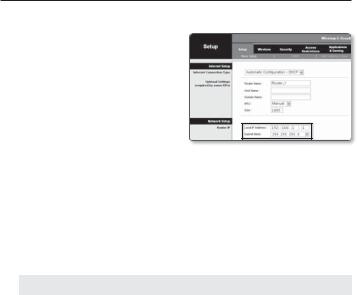
network connection and setup
If using a Broadband Router
•IP Address : Enter an address falling in the IP range provided by the Broadband Router.
ex) 192.168.1.2~254, 192.168.0.2~254, 192.168.XXX.2~254
•Subnet Mask : The <Subnet Mask> of the Broadband Router will be the
<Subnet Mask> of the camera.
•Gateway : The <Local IP Address> of
the Broadband Router will be the <Gateway> of the camera.
MThe settings may differ depending on the connected Broadband Router model. For more information, refer to the user manual of the applicable router.
Refer to the “Port Range Forward (Port Mapping) Setup” section of the Broadband Router’s documentation. (Page 29)
If the Broadband Router has more than one camera connected
Configure the IP related settings and the Port related settings distinctly with each other.
ex)
|
Category |
Camera #1 |
Camera #2 |
|
IP related settings |
|
IP Address |
192.168.1.100 |
192.168.1.101 |
|
Subnet Mask |
255.255.255.0 |
255.255.255.0 |
|
|
|
Gateway |
192.168.1.1 |
192.168.1.1 |
Port related settings |
|
HTTP Port |
8080 |
8081 |
|
VNP Port |
4520 |
4521 |
|
MIf the <HTTP Port> is set other than 80, you must provide the <Port> number in the address bar of the Internet browser before you can access the camera.
ex) http://IP address : HTTP Port http://192.168.1.100:8080
26_ network connection and setup
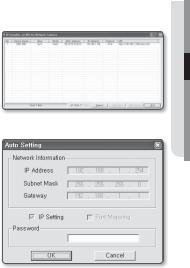
Auto Network Setup
Run <IP Installer_vX.XX.exe> to display the camera search list.
At the initial startup, both [Auto Set] and [Manual Set] will be grayed out.
MFor cameras found with the IPv6 setting, these buttons will be grayed out as the cameras do not support this function.
1.Select a camera in the search list. Find the MAC (Ethernet) address labeled on the rear of the camera. Both the [Auto Set] and [Manual Set] buttons will be activated.
2.Click [Auto Set].
The Auto Setting dialog appears.
The <IP Address>, <Subnet Mask>, and <Gateway> will be set automatically.
3.Enter the password.
This is the login password for the “admin” user who accesses the camera. The default password is “4321”.
The default password can be exposed to a hacking thread so it is recommended to change the password after installing the product.
Note that the security and other related issues caused by the unchanged password shall be responsible for the user.
If you want to change the password, refer to
“Administrator Password Change” of the user setup. (page 63)
4.Click [OK].
Auto network setup will be completed.
SETUP AND CONNECTION NETWORK ●
English _27

network connection and setup
DYNAMIC IP SETUP
Dynamic IP Environment Setup
•Example of the Dynamic IP environment
-If a Broadband Router, with cameras connected, is assigned an IP address by the DHCP server
-If connecting the camera directly to modem using the DHCP protocols
-If IPs are assigned by the internal DHCP server via the LAN
Checking the Dynamic IP
1.Run the IP Installer on the user’s local machine to display cameras allocated with <Dynamic IP> addresses in the list.
2.Select a camera in the list, and click [Manual Set] to check the <Dynamic IP> of the camera.
If you uncheck <DHCP>, you can change IP to <Static>.
28_ network connection and setup
